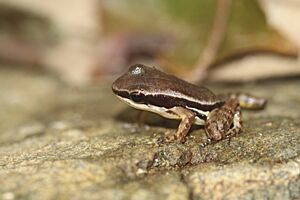Colostethus pratti facts for kids
Quick facts for kids Colostethus pratti |
|
|---|---|
 |
|
| Conservation status | |
| Scientific classification | |
| Synonyms | |
|
Phyllobates Pratti Boulenger, 1899 |
The Colostethus pratti is a cool little frog! It's also known as the Pratt's rocket frog. This frog belongs to the Dendrobatidae family, which includes many colorful poison dart frogs.
You can find this frog in parts of Colombia and Panama. It might even live in southeastern Costa Rica. The frog got its name from Antwerp Edgar Pratt, an explorer who first found these frogs.
Contents
What Does the Pratt's Rocket Frog Look Like?
The Pratt's rocket frog is quite small. Both male and female frogs grow to be about 24 millimeters long. That's less than an inch!
They are usually brown on top. You can spot them by the dull stripes along their backs. These stripes are a special feature of this frog.
How Do Pratt's Rocket Frogs Have Babies?
Scientists have watched these frogs have babies in special labs. Male frogs make a loud, peeping sound to attract females. This is called an "advertisement call."
Males can be a bit feisty with each other. They might even "wrestle" to protect their small areas.
- Laying Eggs: Female frogs lay their eggs on leaves or in hidden spots. Each group of eggs has about 8 to 20 eggs. They usually lay eggs during the wet season.
- Hatching: The tiny eggs hatch in about one to two weeks.
- Tadpole Travel: After hatching, the mother frog carries the baby tadpoles on her back. She takes them to a nearby pond or stream. She might carry them for several days!
- Growing Up: Once in the water, the tadpoles are on their own. They change into froglets in about 8 to 13 weeks.
- New Froglets: When they first change, the froglets are very small, only 6 to 8 millimeters long. Some male frogs start calling for mates when they are only six months old!
Where Do Pratt's Rocket Frogs Live?
The Pratt's rocket frog is a common type of frog. It likes to live in warm, wet forests. You can find them on the forest floor. They also like to hang out near rocky parts of forest streams.
Are Pratt's Rocket Frogs Safe?
Even though people are cutting down forests and causing pollution, this frog is not considered in danger. There are many of them living across a wide area. This means they are not currently threatened.


